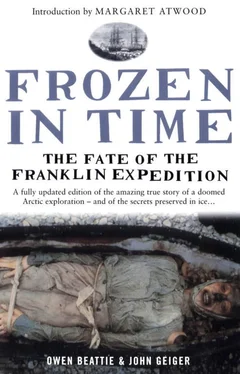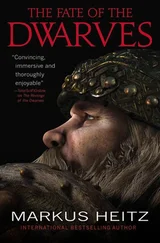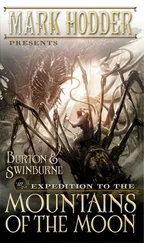Despite the official acknowledgement that no more relief expeditions would be sent, interest in the Franklin search—and in the Arctic in general—remained high in Britain. Three Inuit (or “Esquimaux” as the Victorians called them) were taken to England by a merchant and given an audience with Queen Victoria at Windsor Castle, then “exhibited” in London. “The painful excitement which has so long pervaded the minds of all classes with respect to the fate of Sir John Franklin’s Arctic Expedition lends additional interest to the examination of these natives of the dreary North,” the Illustrated London News commented. Interest among North Americans did not always match that of the British public’s, however. In one instance, the Toronto Globe complained that only a handful of people attended a lecture on the Arctic and the possible fate of Sir John Franklin, while the same hall had been “filled to overflowing” with those curious to view the famous midget Tom Thumb.
Finally, on Monday, 23 October 1854, under the headline “Startling News: Sir John Franklin starved to death,” the Toronto Globe reported “melancholy intelligence” that had arrived in Montreal two days earlier. After his failed earlier investigations, the Hudson’s Bay Company’s John Rae had made the first major discovery of the Franklin searches while surveying the Boothia Peninsula. The Globe excitedly outlined the news:
From the Esquimaux [Rae] had obtained certain information of the fate of Sir John Franklin’s party who had been starved to death after the loss of their ships which were crushed in the ice, and while making their way south to the great Fish [Back] river, near the outlet of which a party of whites died, leaving accounts of their sufferings in the mutilated corpses of some who had evidently furnished food for their unfortunate companions.
Two days later, the Globe argued that Rae had succeeded “in revealing to the world the mysterious fate of the gallant Franklin and his unfortunate companions, and in proving the folly of man’s attempting to storm ‘winter’s citadel’ or light up ‘the depths of Polar night.’” By 28 October 1854, word had reached Britain that the veil that obscured the fate of Sir John Franklin had been lifted. In a letter to the Secretary of the Admiralty, Rae outlined his discoveries:
…during my journey over the ice and snow this spring, with the view of completing the survey of the west shore of Boothia, I met with Esquimaux in Pelly Bay, from one of whom I learned that a party of ‘whitemen’ (Kablounans) had perished from want of food some distance to the westward… Subsequently, further particulars were received, and a number of articles purchased, which place the fate of a portion, if not all, of the then survivors of Sir John Franklin’s long-lost party beyond a doubt—a fate terrible as the imagination can conceive.
Rae went on to report descriptions of a party of white men dragging sledges down the coast of King William Island, of the discovery a year later of bodies on the North American mainland and evidence of cannibalism. Contrary to the Toronto Globe headline, there was no proof that Franklin himself had starved to death, but disaster had clearly befallen his crews. Evocatively, the Inuit also told Rae that “they had found eight or ten books where the dead bodies were; that those books had ‘markings’ upon them, but they would not tell whether they were in print or manuscript.” When Rae asked what they had done with the books, possibly expedition logs, he was told that they had given them to their children, “who had torn them up as playthings.” In support of the Inuit accounts, Rae carried with him items he had been able to purchase from the natives, including monogrammed silver forks and spoons, one of them bearing Crozier’s initials, and Sir John Franklin’s Hanoverian Order of Merit.
Because Rae’s information about the cause of the expedition’s destruction came second-hand, it was judged inconclusive by many, though the relics were evidence enough that “Sir John Franklin and his party are no more.” The British government, enmeshed in the Crimean War, asked the Hudson’s Bay Company to follow up on the new information. Its chief factor, James Anderson, was able to add only slightly to Rae’s report when he discovered several articles from the Franklin expedition on Montreal Island and the adjacent coastline, including a piece of wood with the word “Terror” branded on it, part of a backgammon board and preserved meat tins—but no human remains or records. Anderson’s search, which lasted only nine days, would be the last official attempt to learn the fate of Franklin. Rae, though attacked by critics for not following up on the Inuit reports and instead hurrying back to London, was given £8,000 in reward money; the men in his party split another £2,000.
The British public and government interest quickly turned to the Crimean War. The very week that news of Rae’s discoveries reached Britain, a confusion of orders resulted in a brigade of British cavalry charging some entrenched batteries of Russian artillery. A report in the Times captivated Franklin’s nephew, the poet Alfred, Lord Tennyson, who immortalized the encounter where so many British horsemen died in his “The Charge of the Light Brigade.” Events had finally overtaken the disappearance of Sir John Franklin and his officers and crews, leaving many to believe that the mystery of the expedition’s destruction would never be solved. In addition, there were others who questioned the value of research expeditions such as Franklin’s, which demanded such a heavy toll. Blackwood’s Edinburgh Magazine summed up this view better than any other journal in an article published in November 1855:
No; there are no more sunny continents—no more islands of the blessed—hidden under the far horizon, tempting the dreamer over the undiscovered sea; nothing but those weird and tragic shores, whose cliffs of everlasting ice and mainlands of frozen snow, which have never produced anything to us but a late and sad discovery of depths of human heroism, patience, and bravery, such as imagination could scarcely dream of.
Yet there were still those who had not given up on Arctic expeditions, who still believed that the answers to Franklin’s fate lay somewhere on King William Island or on the mainland close to the mouth of the Back River. Foremost among them was Lady Franklin, who made one last impassioned plea to British Prime Minister Lord Palmerston: “…the final and exhaustive search is all I seek on behalf of the first and only martyrs to Arctic discovery in modern times, and it is all I ever intend to ask.” She failed to convince the British government to send one final search, and launched another expedition of her own. No longer seeking the rescue of Franklin, she now sought his vindication.
Jane, Lady Franklin, neé Griffin, aged twenty-four.
Lady Franklin, born Jane Griffin, personified the romantic heroine with her refusal to give up hope that searchers would one day discover the fate of her husband and his crews. Her determination, coupled with a willingness to spend a large part of her fortune to outfit four such expeditions, haunted the Victorian public as much as it inspired the searchers of her day. “To know a loss is a single and definite pain,” the Athenaeum observed, “to dread it is a complicated anguish which to the pain of the fear adds the pain of the hope… The misery is, that if the truth be not known, Lady Franklin will nurse for years her frail hope, almost too sickly to live and yet unable to die.”
What makes the devotion of Lady Franklin especially moving is the recognition that she was an independent and free-thinking woman who had not married until her thirties, and who saw more of the world than possibly any other woman of her day. During her long vigil, Lady Franklin not only implored the British for help, but the president of the United States and the emperor of Russia as well. She became an expert in Arctic geography. One famous folk song, “Lord Franklin,” captured the passion of her search:
Читать дальше










